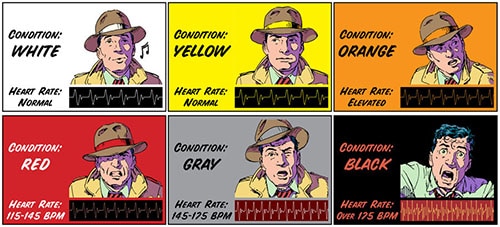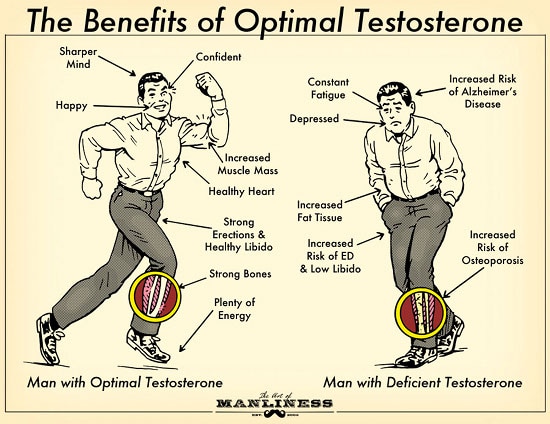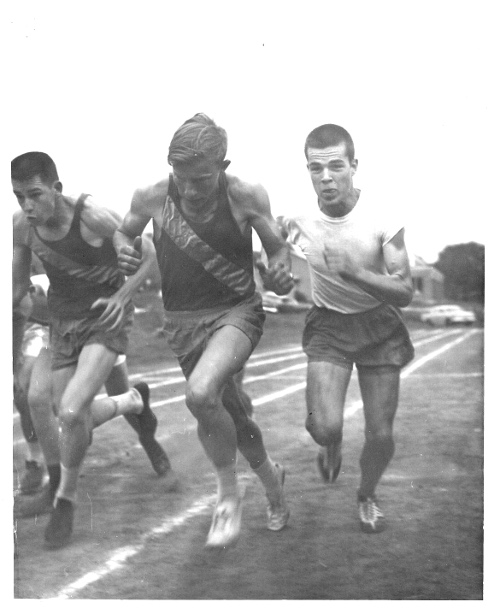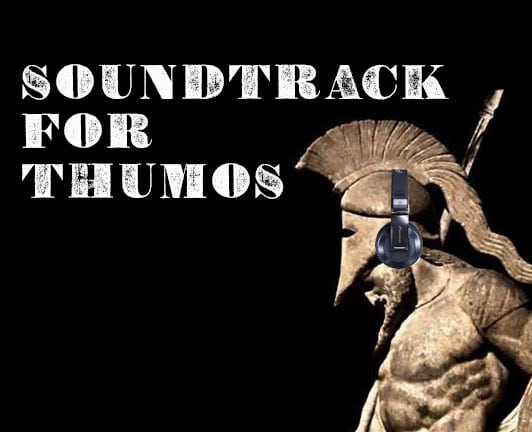Click here to see a larger version of the image.
Think back to the last time you experienced a high amount of psychological stress. For example, after you were in a fender bender or before you had to give a big speech in front of hundreds of people.
How was your thinking? A bit scattered?
Did performing simple tasks like writing or tying your shoe become difficult because of how much your hands were shaking?
If you’re like many people, you likely experienced small cognitive and physical breakdowns due to fear and stress. Whenever we encounter stressful situations, our body is flooded with hormones that elevate our heart rate to prime us to fight or flee. Our bodies become aroused and ready for action – a good thing. But if we get too amped up, our physical and cognitive skills fall apart – a very bad, potentially dangerous thing.
Now imagine what your response would be if you were in the middle of a gunfight with a bad guy.
How do you imagine your thinking would be then? Would you even be able to think?
Would you be able to respond with like force or would you just freeze like a deer in headlights?
In life-or-death situations, be it a firefight or an emergency evacuation, it’s often the psychological stress that gets a man killed. Or more specifically, his inability to manage that stress.
In today’s post we’re going to highlight some of the research from recent years that shows what stress does to a man’s ability to perform in high-risk scenarios. Moreover, we’ll introduce a color code system developed by one of history’s best shooting experts that many warriors (soldiers, fighters, police officers, first responders, and even average joes interested in beyond average training) use to gauge their mental and physical preparedness in life-or-death situations. We’ll end the post by discussing a few of the research-backed techniques that warriors around the world are beginning to use to mitigate stress, allowing them to perform at optimal levels even in the heat of a crisis.
While much of the research and content in this post is geared towards helping you become a better sheepdog, the principles and techniques can also be used to manage stress in everyday situations, whether that be a tough challenge at home, at work, or on the playing field. Even if you don’t plan on getting in a close-quarters firefight anytime soon, you can definitely benefit from this information.
The Inverted-U Theory of Stress and Performance

The Inverted-U Hypothesis proposes that increases in stress typically are accompanied by increases in quality of performance…only up to a point, though. After you reach a certain threshold, you experience diminishing returns where rising stress actually results in deteriorating performance quality in certain tasks.
Several sports performance researchers during the 1970s and 1980s found that athletes experienced increases and decreases in different motor skills at different stress-induced heart rates. For example, when heart rates reach above 115 beats per minute (BPM), fine motor skills, like writing, begin to deteriorate. However, when heart rates are between 115 and 145 BPM, complex motor skills, like throwing a football or aiming a gun, are at their peak. Cognitive functioning is also at its peak in this range. After 145 BPM, performance for complex motor skills begins to diminish, but gross motor skills like running and lifting remain at optimal levels. When heart rates go above 175 BPM, capacity for all skilled tasks disintegrates and individuals begin to experience catastrophic cognitive and physical breakdown.
While most of the research on stress and performance has been used in the realm of sports, researchers who study combat and tactical scenarios are beginning to use the Inverted-U hypothesis to help warriors of all kinds become better fighters and responders. By knowing how stress impacts their performance in life-or-death situations, warriors are able to take steps to help mitigate its effects either through training or stress-management techniques.
Physiological vs. Psychological Stress
As we discuss arousal (in reference to stress and heart rate) and its effect on performance, it’s important to note that there’s a big difference between heart rate increase caused by physiological versus psychological stress. You likely won’t see major deterioration in cognitive and physical performance when heart rates increase due to physical exercise. For example, you’re probably not going to experience tunnel vision after you get your heart rate up from a bunch of wind sprints.
It’s typically only when your heart rate increases rapidly due to psychological stress (e.g., fear in a deadly force encounter) that you’ll experience the significant negative effects of stress arousal.
The Stress Arousal Color Code
In his seminal book, Principles of Personal Defense, gun fighting expert Jeff Cooper laid out a color code system to help warriors gauge their mindset for combat scenarios. Each color represents a person’s potential state of awareness and focus. Originally, Cooper’s color code system only used white, yellow, orange, and red.
In recent years, combat researchers, like Lt. Col. Dave Grossman and Bruce K. Siddle, added two more levels, gray and black, for reasons we’ll dig into more later on in the post. Moreover, they combined Cooper’s system with the Inverted-U chart of arousal and performance to create a framework that associates a color level with a heart rate arousal level. Below we summarize this synthesis with text and illustrations.
Condition White

When you’re in Condition White, you’re completely unaware and un-alert to your surroundings. If a threat were to appear, you’d be caught off-guard and wouldn’t be able to respond adequately. Visual and cognitive reaction times are much slower in Condition White and we’re much more susceptible to Normalcy Bias. Because most people are sheep and not sheepdogs, Condition White is the norm in society. Ideally, the only time you should be in Condition White is when you’re secure in your home or asleep. When you leave the house, you should leave Condition White.
Condition Yellow

Condition Yellow is best described as relaxed alert. There’s no specific threat situation, but you have your head up and eyes open, and you’re taking in your surroundings in a relaxed, but alert manner. When you’re in Condition Yellow, you’re less likely to be caught off-guard from a sudden threat and you are better able to respond should a threat arise. Heart rate is normal, so there isn’t any degradation of fine motor skills or cognitive ability.
Tactical experts recommend that warriors stay in Condition Yellow at all times. In fact, many Air Force pilots stick a yellow dot on their watch or in the cockpit to remind them to stay in Condition Yellow.
Condition Orange
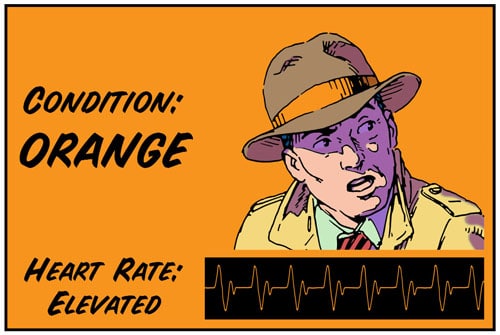
You enter Condition Orange when you identify a possible, specific threat. Something isn’t quite right and has your attention. Your goal isn’t to take action while in Condition Orange. Rather, it is to become extra vigilant so you can determine if a possible danger is in fact a threat that needs a response. Maybe you smell smoke, or perhaps you identify a person in the water who may be drowning, or maybe the guy walking towards you in a dark side-street is acting funny. In all of those situations, you’d want to be in Condition Orange.
While in Condition Orange, you should be formulating an attack plan on what you’ll do if you verify the threat, e.g., “If there’s a fire, I’ll call 911,” or “If he’s drowning, I’ll jump in and rescue him,” or “If he pulls out a gun, I’ll pull mine and shoot.”
When you’re in Condition Orange, stress levels will increase, as will your heart rate. However, you shouldn’t experience any cognitive or motor deterioration.
Staying in Condition Orange’s increased vigilance level on a regular basis isn’t recommended as it can be mentally and physically taxing. If you verify that a possible threat isn’t a threat, you should immediately drop back down into Condition Yellow’s relaxed alert. However, if you confirm that something or someone is indeed a threat, you should immediately move to…
Condition Red
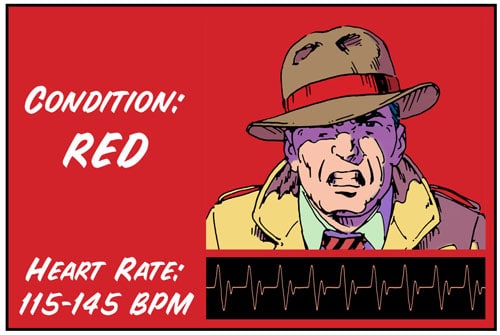
You’ve verified the threat — now it’s time to implement the action plan you developed while in Condition Orange. When you’re in Condition Red, your mind and body are primed for action. Adrenaline is pumping through your veins and your heart rate is up to between 115 and 145 beats per minute. Studies have shown this to be the optimal level for tactical and survival scenarios. Complex motor skills, visual reaction times, and cognitive reaction times are at their peak.
While complex motor skills and visual and cognitive reaction times are at their best in Condition Red, fine motor skills, like writing or threading flex cuffs, deteriorate.
Condition Gray
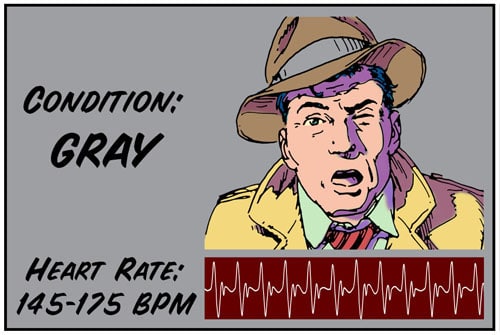
Condition Gray wasn’t part of Cooper’s original color system, but after analyzing years of research, Grossman and his colleagues added it. When you reach Condition Gray, your heart rate rises above the optimal range of 115-145 BPM and goes up to 145-175 BPM. Consequently, mental and physical performance begins to suffer dramatically and puts the fighter at risk of being injured or killed.
Tunnel vision and loss of depth perception is common, which means a fighter may miss additional threats in the vicinity. Tunnel vision also often causes fighters to “not see” innocent third-party bystanders in a fight. This phenomenon is a big reason why most firearms trainers these days instruct students to get in the habit of scanning their environment after they neutralize a threat. The simple act of looking side-to-side can help disrupt tunnel vision.
Auditory exclusion is another common symptom of Condition Gray. Fighters who’ve experienced auditory exclusion report not hearing their partner’s gun fire, even though the gun was going off right next to him. However, they’ll often remember hearing shouts from their partner.
Complex motor skills, like gun manipulation or non-armed combatives, begin to suffer in Condition Gray. Gross motor skills, like running, jumping, pulling, and pushing are still at optimal levels.
One possible and positive symptom you may experience in Condition Gray is “bullet time”– a mental phenomenon in which everything around you appears to be moving in slow motion, a la The Matrix. Bullet time can give a fighter more clarity and help him react. In his study on deadly force encounters, Dr. Alexis Artwohl surveyed police officers who had experienced deadly force encounters and found that nearly 62% of them experienced slow-motion time.
It’s called “Condition Gray” because Grossman believes more research needs to be done on arousal levels where the heart reaches 145-175 BPM. Grossman notes in his book On Combat that while most untrained men will begin to experience the mental and physical deterioration outlined above, some fighters are still able to perform at optimal levels in Condition Gray. Research indicates that with proper training and stress inoculation, fighters can properly and safely “push the envelope” of Condition Red into the elevated heart rates of Condition Gray.
Condition Black

Condition Black wasn’t part of Cooper’s original system either, but was added by the U.S. Marine Corps. When you reach Condition Black, your heart is beating faster than 175 BPM. At this level of arousal, a fighter — even a well-trained one — experiences catastrophic breakdown of mental and physical performance.
In addition to tunnel vision, auditory exclusion, and deterioration of complex motor skills, other symptoms are present in Condition Black.
Most fighters will experience bladder and bowel voiding — in other words, they poop and pee their pants. In high-stress, life-or-death situations, sphincter and bladder control just aren’t a priority for your body. Moreover, it wants to get rid of as much waste as it can so you’re in a better position to fight or run. At this point, the decisions your physical body makes are overriding any cognitive ones. Lt. Col. Grossman actually discusses this issue in great detail in On Combat. While many soldiers and fighters won’t admit publicly that they messed themselves, in anonymous surveys conducted after WWII, one-quarter of soldiers admitted they peed themselves during combat and one-eighth admitted to defecating. Grossman believes the number was likely even higher than that.
Extreme vasoconstriction is also typically present in Condition Black. Vasoconstriction is when the blood vessels narrow to constrict blood flow. In life-or-death situations, your body wants most of your blood to stay near vital organs and large muscles that can be used to fight or run. One benefit of this is that if you were to sustain a wound, vasoconstriction helps limit the amount of bleeding you experience. Extreme vasoconstriction causes people to look “white with fear” as all the blood has been shunted away from the skin’s surface to more vital parts of the body. While this is a survival mechanism, it unfortunately leads to deterioration of complex motor skills.
Another physical reaction is that your forebrain (the executive part of your brain) shuts down and your more primitive middle brain takes over. Grossman calls this the “puppy dog” brain. Without executive functioning, you’re susceptible to irrational fighting or fleeing. As an example of this type of irrational behavior, many soldiers fighting in the frontlines of WWI and WWII reported seeing comrades run out from behind protection and into enemy fire without any rhyme or reason. As Grossman puts it, “in Condition Black you can run and you can fight like a big, hairless, clawless bear, but that is about all you are capable of doing.”
In that same study conducted by Dr. Artwohl mentioned above, he found that a very small percentage of police offers experienced freezing, or temporary paralysis during a deadly force encounter. In these cases, the body doesn’t fight or run, it just stops cold, leaving the fighter very vulnerable.
Managing Arousal in High-Stakes Situations
Now that we understand how stress alters our performance, let’s take a look at some of the things that combat researchers have found help mitigate its effects. While you can’t completely control where your heart rate goes in a high-stress situation, learning and practicing certain techniques can help you lower it and maximize your resistance to stress, allowing you to perform at optimal levels for as long as possible.
Practice tactical breathing. Tactical breathing was developed by Lt. Col. Dave Grossman. It’s a technique that soldiers and police officers use to quickly calm down and stay focused during firefights. Here’s how to do it:
- Slowly inhale a deep breath for 4 seconds.
- Hold the breath in for 4 seconds.
- Slowly exhale the breath out for 4 seconds.
- Hold the empty breath for 4 seconds.
- Repeat until your breathing is under control.
Simple. What’s hard is having the discipline to do this when you start feeling stressed out.
Tactical breathing isn’t just useful for deadly force encounters. Use it anytime you’re feeling stressed out and need to bring yourself back down to optimal arousal levels.
Meditate. Studies show that individuals who practice meditation can clear distracting and stressful thoughts (like worry) from their mind more quickly than individuals who don’t meditate. That sort of ability comes in handy in high-stress situations like deadly force encounters.
The U.S. military is actually experimenting with mindfulness meditation training with its new recruits. The hope is that meditation’s stress-reducing benefits will help soldiers stay out of Condition Black while in the heat of combat, as well as help them recover more quickly after the encounter.
There’s not much to meditation. Just sit in a quiet place and focus on your breath going in your nose and out your mouth. Whenever a distracting thought pops up, don’t get flustered. Just name the thought, let it go, and focus back on your breath. If you’re like me, you’ll find that when you first start meditating, you get easily distracted by your thoughts. Don’t get discouraged; with time your mind will quiet down, and your ability to dismiss unwanted thoughts will improve.
Start off with one 10-minute session daily, and slowly increase your sessions to 20 minutes. If you have time, you may consider doing a 20-minute meditation session in the morning and another 20-minute session at night.
Practice visualization. Emerging research shows that warriors who visualize hypothetical high-stress scenarios perform better in actual high-stress situations than those who don’t. For example, officers who take part in visual exercises demonstrate better marksmanship than those who skip this technique.There’s also evidence that visualizing successful management of high-stress situations reduces a combatant’s anxiety and stress response when the events actually occur, thus allowing the fighter to stay in optimal Condition Red longer.
Here are some rough and ready guidelines on performing visualization exercise:
- Make the visualization as vivid as possible. Incorporate all your senses and emotions.
- Visualize problems and sticking points, but — and this is the critical part — always visualize yourself successfully overcoming the problem or obstacle. Never visualize failure.
- Never rely on visualization alone. It’s important to combine it with tactical practice and role playing.
Use task-relevant instructional self-talk. To counter the detrimental performance effects of stress, talk yourself through complex actions as if you were an instructor. For example, many police officers are trained to speak out loud during every step in the gun firing process using the acronym BRASS:
- Breathe
- Relax
- Aim
- Sight
- Squeeze
Another example of task-relevant instructional self-talk would be to yell out “Tap, Rack, and Go!” whenever you encounter a gun jam.
Don’t worry if people think you’re crazy. Research has shown that this sort of self-talk can increase performance on both cognitive and physical tasks.
The key with this type of self-talk is to keep it brief and positive.
Stay active and outwardly focused. In the book War, by Sebastian Junger (which I highly recommend), he shares an interesting study done on a Special Forces team during the Vietnam War. The team was stationed at an isolated base along the Cambodian border and knew there was a good chance of the base being completely overrun by a force of Vietcong. Surprisingly, researchers found that in contrast to the officers, the stress levels of the enlisted men actually dropped before an expected attack, and rose when the attack failed to materialize. Researchers offered this explanation: “The members of this Special Forces team…were action-oriented individuals who characteristically spent little time in introspection. Their response to any environmental threat was to engage in a furor of activity which rapidly dissipated the developing tension.” This activity included laying C-wire and mines around the base, which as Junger notes, “was something they knew how to do and were good at, and the very act of doing it calmed their nerves.”
When you’re facing a threat you can anticipate in advance, take a cue from the men of the Special Forces; instead of sitting around navel-gazing, bouncing your leg up and down, and getting your heart rate up before anything even happens, keep yourself occupied with preparations – check your equipment, mentally rehearse your mission, etc.
Stress Inoculation Through Realistic Training
Remember the old saying amongst soldiers: “You do not rise to the occasion in combat, you sink to the level of training.”
Thus, the best way to overcome the detrimental effects of stress on performance is to inoculate yourself from it altogether through consistent, realistic training.
From a self-defense standpoint, this means you need to do more than just go to the gun range to practice your marksmanship or punch the heavy bag in your garage. You’ll actually need to train your techniques under the same sort of pressure you’d experience in a real-life situation. For handgun training, this could be achieved with simunitions or airsoft guns; with hand-to-hand self-defense, live sparring can give you similar stress levels as a real-life fight.
With proper, consistent, and realistic training, you can hone your body to perform at optimal levels, even when the going gets the toughest.
____________________
Sources:
Sharpening the Warrior’s Edge by Bruce K. Siddle
On Combat by Dave Grossman and Loren W. Christensen
Warrior Mindset by Dr. Michael Asken, Loren W. Christensen, Dave Grossman and Human Factor Research
Illustrations by Ted Slampyak
Tags: Self-Defense & Fighting

